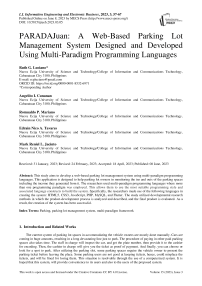PARADAJuan: A Web-Based Parking Lot Management System Designed and Developed Using Multi-Paradigm Programming Languages
Автор: Ruth G. Luciano, Angelito I. Cunanan, Romualdo P. Mariano, Edrain Nico A. Tavares, Mark Reniel L. Jacinto
Журнал: International Journal of Information Engineering and Electronic Business @ijieeb
Статья в выпуске: 3 vol.15, 2023 года.
Бесплатный доступ
This study aims to develop a web-based parking lot management system using multi-paradigm programming languages. This application is designed to help parking lot owners in monitoring the ins and outs of the parking spaces including the income they generated from it. The researchers used multi-paradigm programming languages where more than one programming paradigm was employed. This allows them to use the most suitable programming style and associated language constructs to build the system. Specifically, the researchers made use of the following languages in creating the system: HTML5, CSS3, JavaScript, PHP, MySQL, and Flutter. The study utilized developmental research methods in which the product-development process is analyzed and described, and the final product is evaluated. As a result, the creation of the system has been successful.
Parking, parking lot management system, multi-paradigm framework
Короткий адрес: https://sciup.org/15018873
IDR: 15018873 | DOI: 10.5815/ijieeb.2023.03.05
Текст научной статьи PARADAJuan: A Web-Based Parking Lot Management System Designed and Developed Using Multi-Paradigm Programming Languages
Published Online on June 8, 2023 by MECS Press
1. Introduction and Related Works
The current system of parking lot spaces in accommodating the vehicle owners are mostly done manually. Cars are coming in huge amounts, resulting in a long devastating line just to park. The procedure of paying in other paid parking spaces also takes time. The staff in charge will inspect the car, and get the plate number, then provide it to the cashier for encoding. Then, the cashier in charge will give you the ticket as proof of payment. And finally, you can choose or look for a spot to park. After utilizing the parking slot, some parking spaces require the vehicle owner to present the parking ticket before leaving the place. Some parking users are not good at keeping tickets, hence, could misplace the tickets, and will be fined for losing them. This situation is resolvable through the use of a computerized system. It is hoped that this system, will provide convenience to its users and also to the users of the proposed system.
In the study conducted by Barbosa, et al (2018), they presented an application using image analysis for the automatic detection of markers in a parking area, thereby providing efficient monitoring of available parking space without necessarily going to the physical location to check by inspection. [1] They model the system based on the needs of a parking area in a mall leveraging the advantages of the ellipse fitting model. Experiments reveal that their approach provides efficient results in determining available parking spaces.
One limiting factor, however, is that it requires a marker of elliptical shape in each space in order to yield satisfactory results. It hastens the process of finding available parking space without wandering aimlessly until a vacant slot is spotted as it employs automatic detection and counting of space for parking.
Considering the above situation, the researchers aim to develop a system that will give parking users a secure, fast, and convenient experience while using the parking spaces. Instead of registering their vehicles every time they enter the parking space where the proposed system is deployed, the users can sign-up and login to register their vehicles to the main database. These users shall be recognized in any parking space where the system is installed.
2. The Proposed System
During the registration, vehicle owners need to provide some credentials for the vehicle being registered. The plate number is a primary requirement of this system. A photo of the certificate of registration is also one of the main requirements to register a vehicle to this system. After the registration, the system will provide a unique QR code for the registered vehicle that will serve as their identity or gate pass to the parking spaces they will occupy. The provided QR code will be presented by the users upon entering and leaving the parking space. The staff in charge will double-check the plate number of the incoming vehicles to bring up a little security. The system will register the vehicle as “parked” at the given spot as soon as the QR code was scanned successfully. In paid parking slots, the QR code given can be loaded with cash for contactless transactions. The proposed system also provides an e-receipt as proof of a successful transaction. According to Wadsworth, et al (2010), an electronic receipt management system would allow users (merchants, consumers, and financial institutions) access to all receipt data in one location and in one consistent format, thereby eliminating the need for paper receipts. [2]
When the user is leaving the slot/parking space, the user should again present the QR code to the staff-in-charge for the system to be able to mark the vehicle as “out” and the parking slot as “available”. This system will benefit the users and also the cashier or staff in charge. Convenience and the contact-free transaction is the main goal of the system.
Satpalkar, et. al (2016) said that they have developed a new system of Smart Parking to optimize the parking management of vehicles in the city. They implemented a parking reservation technique to balance the benefit of both the service providers and the requirements of the users. Moreover, they have presented the detailed design, implementation, and evaluation of the system and how it works. [3]
Another interesting thing to look at is that GSM technology works with the help of a GSM modem. The functionality of the technology mainly depends on this modem. The modem is placed at the parking end, which generally sends the message to the user if there is any available parking slot. If there is an open slot, the user has to send the exact time and duration for which the vehicle needs to be parked. Once the confirmation message is sent, the reservation's counter automatically starts sending a message. [4]
In RFID, the vehicle owner must register with the parking owner to receive the RFID tag. This tag is to be applied on the vehicle's windshield, so as the car passes through the entry of parking, the RFID scanner scans the label and deducts the amount for parking from the linked account. With this technology, the process speeds up. The entry gate opens when the sensor detects an RFID tag which allows the car inside the parking area. Simultaneously, the parking counter increments by one. Similarly, the exit gate opens, and the parking counter is decreased. [5]
3. Methodology
The researchers made use of the developmental research methodology. Ibrahim, as cited by Luciano, et al. (2020) defined this as a product-development process that involves situations in which the is analyzed and described, and the final product is evaluated. [6-8]
During the development process, the researchers followed the system development life cycle model. They started with the planning phase where they interview individuals to get information about the system to be developed. After the planning phase, they proceed to analyze the data they have gathered. From the results of the analysis they conducted, they came up with design models that are beneficial in preparing the system prototype. These design models are presented below. When the system prototype is developed, an evaluation of the software was done to get feedback from IT experts as to the improvements to be made to it.
The researchers made sure that the system must be able to run in the browsers of modern phones and computers. Backward compatibility is limited to make sure that the system will run as smoothly as possible. Fortado (n.d.) describes this as newer features and plugins that the software will be compatible with. [9] Though the system can support some of the old versions of browsers, it might have inconsistency in terms of performance and the layout of the system’s user interface (UI).
The Android app can be supported by Android 6 and above as it has the lowest population of users, hence, will make the system faster and accessible to a number of users. Specifically, the researchers made use of the following languages in creating the system: HTML5, CSS3, JavaScript, PHP, MySQL, and Flutter.
4. Results and Discussion
This system was designed in accordance with the results of the requirement analysis and reviews done by the researchers. After a thorough review of the needs and some related literature, they came up with the following charts or models which served as their guide in designing and developing the system.
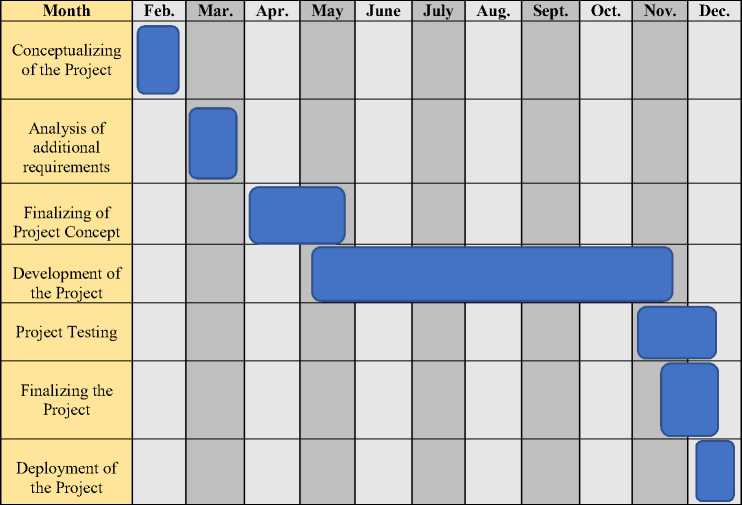
Fig. 1. ParadaJuan’s Gantt Chart
Figure 1 below shows the target date of the development of this project from conception up to deployment. From February to March 2021, the researchers conceptualize the project and work on the user interface of the system. The succeeding months were spent on finishing the entire project in preparation for December 2021 target completion.

Application
Confirmation
Application
Request

Registering
Load Request
Parked Vehicle List Request
Parking Limit Request
Parking Limit
Admin (Manager)
Application Request
Vehicle Registration Notification
Vehicle Confirmation
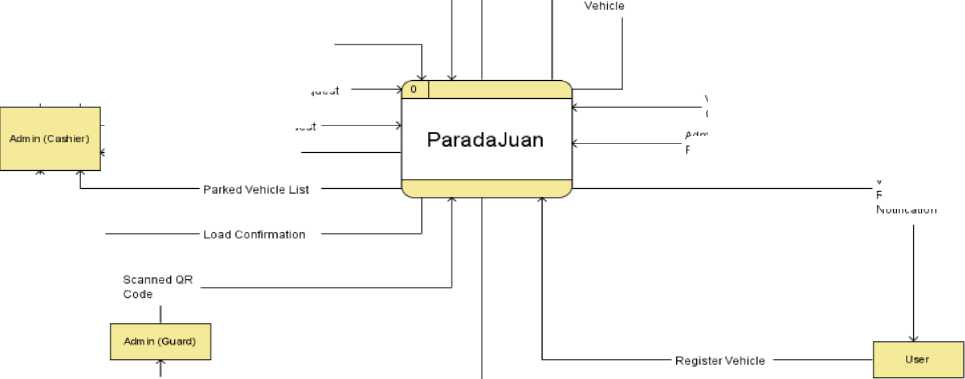
Fig. 2. Context Diagram of ParadaJuan
Vehicle Added
Message
Admin (Manager) Request Confirmation
The figure above shows the data flow between the system and the target users; the Admin, Guard, and Client.
5. Level 0 DFD
Figure 3 presents the user’s role in the system. The users are basically the ones who will enter the parking lot. They are capable of registering accounts, adding vehicles, and loading their account for them to make the necessary payment to their desired parking lot whenever they parked their vehicle.
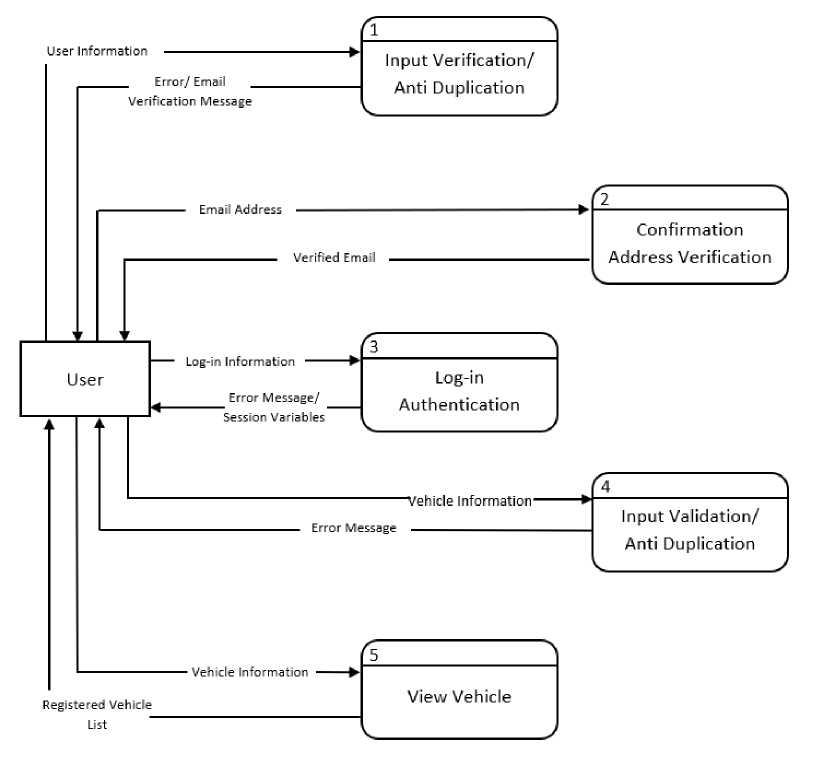
Fig. 3. Level 0 DFD (User)
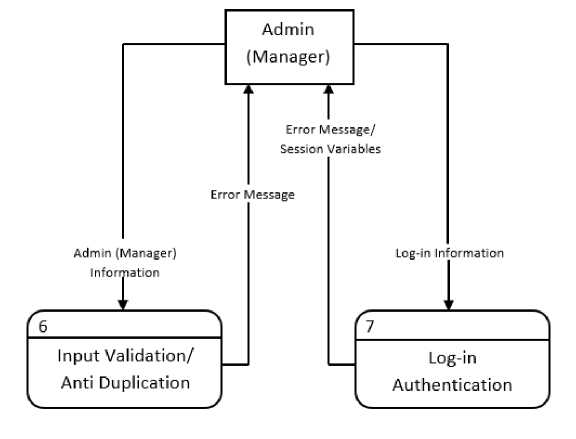
Fig. 4. Level 0 DFD (Admin-Manager)
Generally, the manager is capable of all of the features that the system offers in admins and is presumed that he/she will be the main account handler and is responsible for giving access to guards and cashiers.
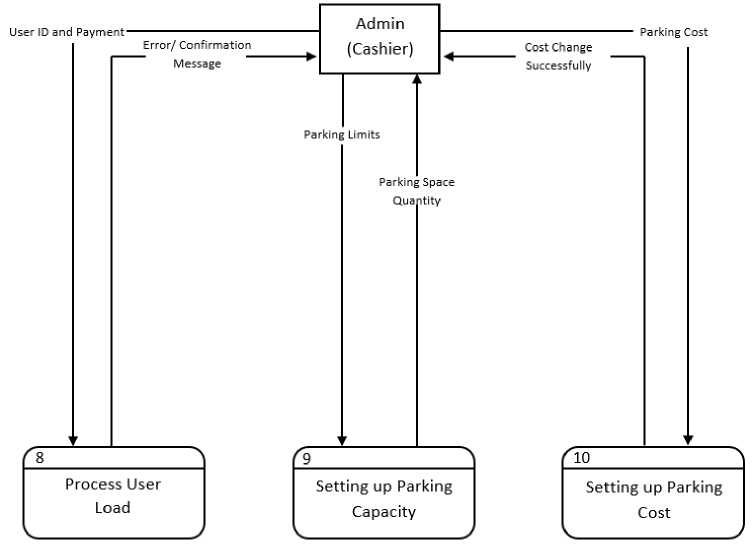
Fig. 5. Level 0 DFD (Admin: Cashier)
This figure shows the admin’s role and capacity in the system. The cashier will be the one who handles and monitors the activities inside the parking lot. In cooperation with their manager, the parking capacity and parking cost will be automatically applied. They are also capable of loading users’ accounts and setting up parking capacity.
Admin
(Guard)
Error Message/ Confirmation
Error Message/ Confirmation
Q.R Code from User
QR Code from User

Verify Vehicle Information for __ Parkingout
11 _______________
Verify Vehicle
Information for
Parking in
Fig. 6. Level 0 DFD (Admin - Guard)
This figure shows the admin role of the guard in using the system. Generally, they are the ones who will use the android application to scan the QR Codes of the user’s vehicle when they enter their parking lot. They can verify if the vehicle is legitimate with the help of the system’s identification.
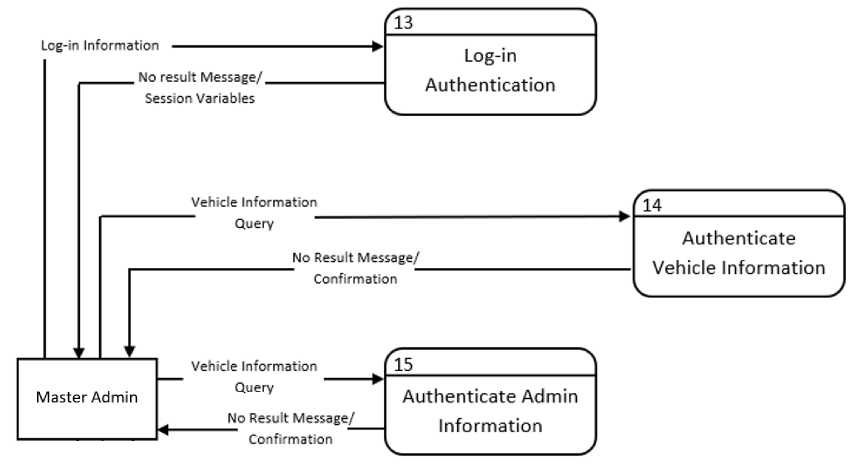
Fig. 7. Level 0 DFD (Master Admin)
Figure 7 shows the master admin’s role in the system. Basically, the job of the master admin is to verify and authenticate the vehicles and admin’s credentials for the system to identify them with accuracy and precision.
6. Use Case Diagram
Fig. 8. Use Case Diagram for End-Users
This figure shows the functions of the project that a user can do or have access to. As shown, users have the following capabilities: sign-up; registration of the vehicle; view transaction history; buy load; and recover his/her account.
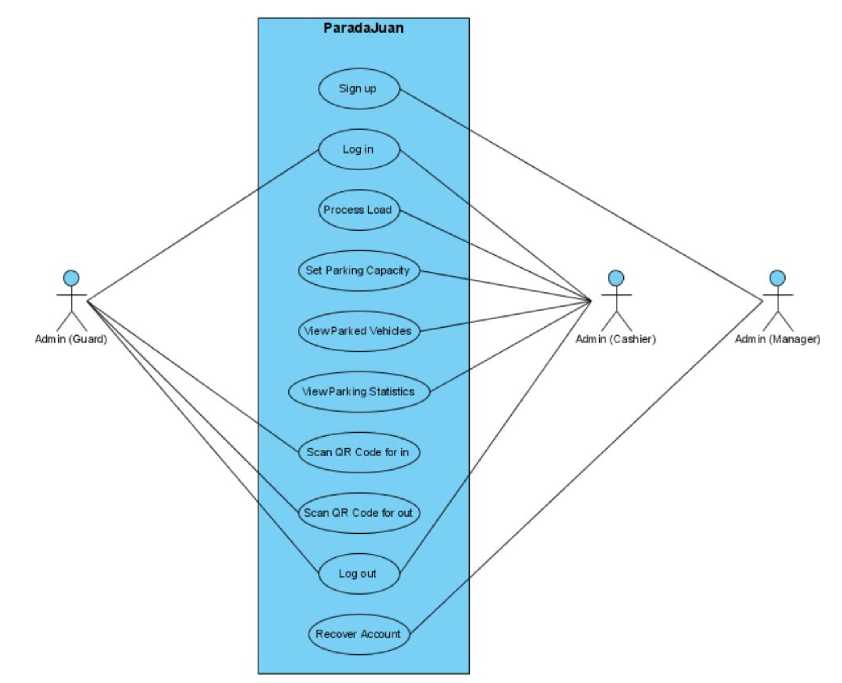
Fig. 9. Admin’s Use Case
Figure 9 and Figure 10 show the functions of the application that the admin can utilize.
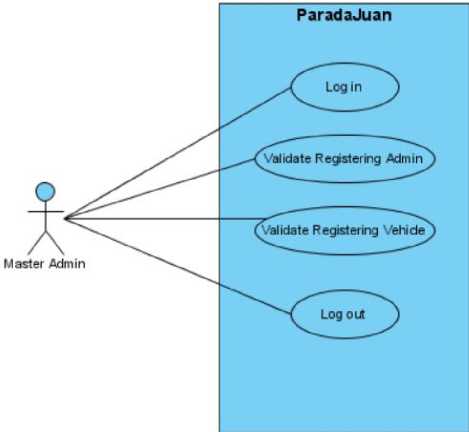
Fig. 10. Master Admin’s Use Case
7. Snapshots of the System
Fig. 11. User Registration Page in Mobile App
This figure shows the page where people can register in the system as a user by filling up the requirements and with the help of the android application.


ParadaJuan is built to give everyone a quick but fun experience in parking their vehicles. With the help of our application, we aim to give people a modern solution to our modern problems regarding traffic and other issues that is related with parking spaces. We are happy that you are a part of our system. Please continue working with us. Have a good day!

Fig. 12. User’s Homepage in Mobile App
This figure shows the page where users will be redirected after they logged in using the system’s android application.
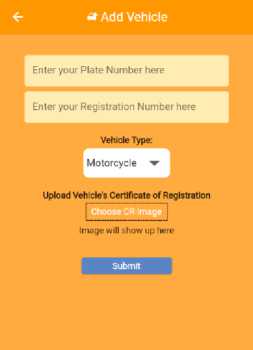
This figure shows the page where users can register their vehicles into the system.
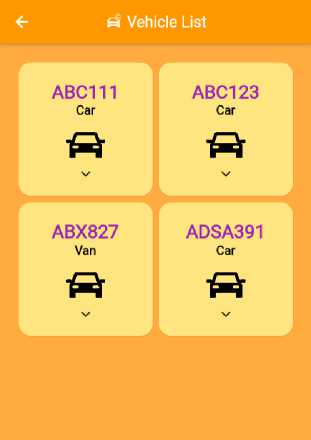
Fig. 14. User’s Vehicle List Page in Mobile App
This figure shows the page where users can see their registered vehicles in the system.
8. Conclusions and Recommendations
ParadaJuan is built to help solve the problems of vehicle owners on the traditional parking system. Not only can ParadaJuan make parking transactions easier, but it can also assure that its users are protected in case they encounter issues inside the parking lot with the help of logs that the system catches whenever a transaction is executed.
The researchers ensure that they did their best to fulfill the system’s goal. Unfortunately, because of the limited access and capacity of the researchers along with the main developer, there are a few features that they didn’t include in the system because of monetary and resource issues. Here are the researchers’ few recommendations for future developers.
The main recommendation of the researchers is to integrate GCash or any third-party application for mobile payment that can load the user’s account so that users don’t need to load their account in a physical cashier anymore. Branchless banking service is not implemented in the system because it needs a working business and the researchers did not have any qualifications or the capacity to avail of the said service including the registration fee for the API.
Their minor recommendation is to build a dedicated QR Code Scanner for the transactions to be faster and for the parking area to be subject to automation especially when the space allows bigger number of parking customers.
Acknowledgement
The researchers would like to thank all the people who in one way or another contributed to the completion of this research project.
Conflict of Interest
The authors declare no conflict of interest.
Список литературы PARADAJuan: A Web-Based Parking Lot Management System Designed and Developed Using Multi-Paradigm Programming Languages
- Barbosa, J., et al (2018). camPark: An Automated Car Parking Space Monitoring System using Image Analysis based on Ellipse Fitting Model. International Journal of Innovative Science and Research Technology ISSN No: 2456-2165 www.ijisrt.com
- K. T. Wadsworth, M. T. Guido, J. F. Griffin and A. Mandil, "An innovation in paper receipts: the electronic receipt management system," 2010 IEEE Systems and Information Engineering Design Symposium, Charlottesville, VA, USA, 2010, pp. 88-93, doi: 10.1109/SIEDS.2010.5469674.
- Satpalkar, et al (2016). Smart City Parking: A QR Code-based Approach. International Journal of Engineering Research & Technology (IJERT) ISSN: 2278-0181, Vol. 5 Issue 02, February-2016 http://www.ijert.org
- Ahmed Shah, Dev Shah , Ajit Satpute , Mihir Shinde, Sunil Shinde (2021), Literature Review on Parking System, International Journal of Engineeringlogy (IJERT) Volume 10, Issue 10.
- Ahmed Shah, Dev Shah, Ajit Satpute , Mihir Shinde, Sunil Shinde (2021), Literature Review on Parking System, International Journal of Engineeringlogy (IJERT) Volume 10, Issue 10.
- Herrera NG, Luciano RG. Design and development of an android-controlled grass-cutting robot using the RPA method. Int J Sci Technol Res 2020; 9(3):223-234. https://www.ijstr.org/final-print/mar2020/Design-And-Development-Of-Android-controlled-Grass-Cutting-Robot-Using-Rpa-Method.pdf
- Luciano, R.G. (2020),‘Design and development of human resource information system (HRIS) for private HEIS,’ International Journal of Scientific & Technology Research, 9(3), 215–222
- Luciano, R. G., Alcantara, G. M., & Bauat Jr, R. (2020). Design and Development of Alumni Tracking System for Public and Private HEIs. International Journal of Scientific & Technology Research, 9(06).
- Fortado, Preethica (n.d.). Technology Glossary: Backward compatibility. https://www.g2.com/glossary/backwards-compatibility-definition

